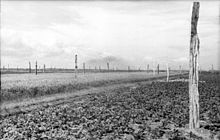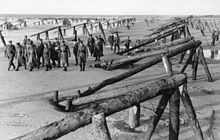Rommel asparagus


Rommel asparagus were four to five meter long tree trunks that were set up in the hinterland of the Atlantic Wall on fields and meadows as well as on beaches in order to make the open spaces unsuitable for air landings with gliders . They are named after Field Marshal Erwin Rommel .
Erwin Rommel, who took over command as Commander-in-Chief of Army Group B in November 1943 , was also in command of the Atlantic Wall on the French Atlantic and Channel coasts. He had the fortifications there checked, often took part in inspection trips himself and came to the conclusion that the defenses had to be expanded much faster and more strongly. The tree trunks rising into the air were named after him as Rommel asparagus .
In order to get to the steel pipes, which were a coveted raw material for the Allies on the coast , they dug up hundreds of Rommel asparagus after the successful invasion. The steel was mainly formed into prongs for the Sherman tanks , which "ate" their way through the hedges of the Bocage hinterland . Such modified tanks were called "Rhinoceros", the prongs "Culin Cutter", after Sergeant Curtis G. Culin.
The term Rommel asparagus was quoted by Günter Grass in his novel “ The Tin Drum ” in a poem by Oskar Matzerath, who is a member of a front theater troupe on the Atlantic Wall on the eve of the Allied landing .
High poles
There were also high stakes or jamming bars that were erected on the beaches of the English Channel and the Atlantic to make it difficult for troops to land at sea. The piles, equipped with mines mounted above or sometimes pointed, were buried up to two meters deep and partly fixed with lateral supports (see photo). Often the logs sat in steel tubes that were supposed to keep the buried part from rotting. They were designed in such a way that at high tide they protruded as close to the water line as possible and could damage the hull of the approaching enemy ships and boats. During the invasion of the Normandy beaches , they were the undoing of some of the Allied landing craft . They were set up at different intervals.
literature
- Sonja Wetzig: Tank obstacles in World War II. Höcker, Rommel asparagus etc. Podzun-Pallas-Verlag GmbH, 2000, ISBN 3-7909-0698-0 .
- Harry Lippmann: Tank traps and other obstacles . IBA, Cologne 1987–1997.
Web links
Individual evidence
- ↑ http://www.ospreypublishing.com/content2.php/cid=133 ( Memento of September 27, 2007 in the Internet Archive )

